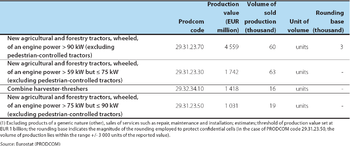Archive:Agricultural and forestry machinery production statistics - NACE Rev. 1.1
This Statistics Explained article is outdated and has been archived - for recent articles on structural business statistics see here.
- Data from January 2009, most recent data: Further Eurostat information, Main tables and Database
This article belongs to a set of statistical articles which analyse the structure, development and characteristics of the various economic activities in the European Union (EU). According to the statistical classification of economic activities in the EU (NACE Rev. 1.1), the present article covers the production of agricultural and forestry machinery, corresponding to NACE Group 29.3, which is part of the machinery and equipment sector. The activities covered in this article include the manufacture of agricultural tractors and other agricultural and forestry machinery, but not agricultural hand tools.
Main statistical findings
The number of agricultural holdings in the EU has been declining rapidly for many years. A lengthy time-series is only available for the EU-15, and this shows that the number of holdings fell from 7.4 million in 1995 to 5.7 million by 2007 (an overall decline of 23.2 %). Within the EU-27, the number of holdings fell by 8.8 % overall between 2005 and 2007 to 13.7 million. This reduction in holdings may reflect a change in land use, or the consolidation of small-sized holdings into larger farms, both of which are likely to result in a reduction in domestic demand for machinery.
Structural profile
The agricultural and forestry machinery manufacturing sector (NACE Group 29.3) was one of the smaller activities within the EU-27’s machinery and equipment (NACE Subsection DK) manufacturing sector. There were 22.2 thousand enterprises for whom this was their principal activity, together employing an estimated 212.0 thousand persons in 2006. The EU-27’s agricultural and forestry machinery manufacturing sector generated EUR 8.9 billion of value added in 2006 from a turnover of approximately EUR 40 billion. This equated to 4.6 % of the total value added for the whole of the machinery and equipment sector, while sectoral shares were somewhat higher in terms of employment (5.8 %) and turnover (6.4 %), and much higher in terms of numbers of enterprises – where the agricultural and forestry machinery manufacturing sector made its greatest contribution to the machinery and equipment sector (12.8 %).
Within the EU-27’s agricultural and forestry machinery sector, the vast majority of activity could be attributed to the other agricultural and forestry machinery (NACE Class 29.32) manufacturing subsector, which accounted for the bulk of sectoral value added (80.4 %), the remainder being generated by the manufacture of agricultural tractors (NACE Class 29.31).
More than one quarter (26.8 %) of the EU-27’s value added in 2006 within the agricultural and forestry machinery manufacturing sector was generated in Germany, the next largest contributions coming from Italy (17.7 %) and France (13.7 %) – the only other Member States to provide double-digit shares. In terms of this sector's contribution to non-financial business economy (NACE Sections C to I and K) value added, Finland and Austria were relatively the most specialised countries for the manufacture of agricultural and forestry machinery[1], as this sector provided 0.4 % of non-financial business economy value added in Finland and 0.3 % in Austria, compared with an EU-27 average of 0.2 %.
EU-27 agricultural and forestry machinery manufacturing output grew by 2.5 % per year, on average, during the period between 1997 and 2007. The development of the index of production followed an uneven pattern, with rapid growth to 1998, followed by a period of almost no change in output through to 2001, a temporary expansion in 2002 and then more renewed growth from 2004 onwards. A particularly rapid increase in production was recorded in 2007 when output rose by 9.5 %.
Expenditure and productivity
The apparent labour productivity of those working in the EU-27's manufacture of agricultural and forestry machinery sector was EUR 42.1 thousand per person employed in 2006, well below the machinery and equipment average (EUR 52.8 thousand) and also low for the machinery and equipment production sector. Average personnel costs within the agricultural and forestry machinery sector were also relatively low, at EUR 31.4 thousand per employee in the EU-27 in 2006, again low for the machinery and equipment production sector. The resulting wage-adjusted labour productivity ratio for the agricultural and forestry machinery sector (134.0 %) was slightly below the machinery and equipment average (135.8 %) and well below the average for the whole of the non-financial business economy (151.1 %).
Data sources and availability
The main part of the analysis in this article is derived from structural business statistics (SBS), including core, business statistics which are disseminated regularly, as well as information compiled on a multi-yearly basis, and the latest results from development projects.
Other data sources include the PRODCOM statistics on the production of manufactured goods.
Context
Technological advancements in the machinery and equipment that is used in other sectors of the economy (particularly in mining, manufacturing, energy provision and construction) can have a considerable impact upon the speed, quality and quantity of what is produced, thereby impacting on downstream productivity and profitability. The machinery and equipment sector is sensitive, therefore, to overall economic conditions and investment patterns both within the European Union and across the world (the two arguably being more intertwined than ever).
Domestic demand for agricultural machinery is closely linked to structural developments and profitability within farming, which in turn are, at least in part, linked to the Common Agricultural Policy and to the opening-up of world agricultural markets.
Further Eurostat information
Publications
Main tables
Database
Dedicated section
See also
- Industry and construction statistics - short-term indicators
- Manufacture of wood and wood products statistics - NACE Rev. 2
Notes
- ↑ Bulgaria, Cyprus, Poland and Romania, 2005; Malta and the Netherlands, not available.


